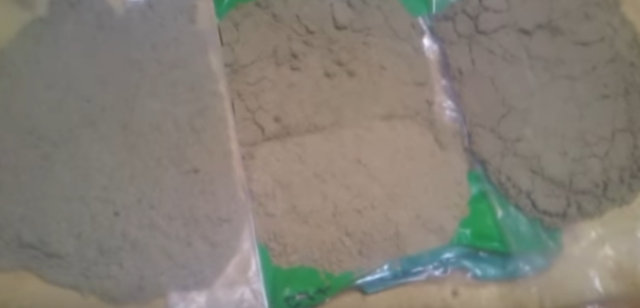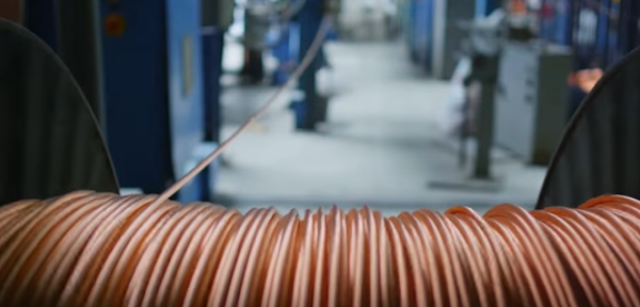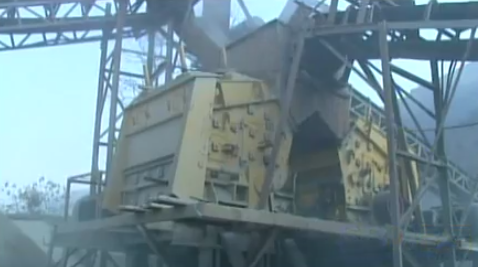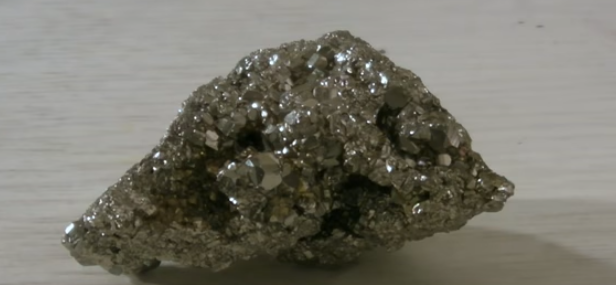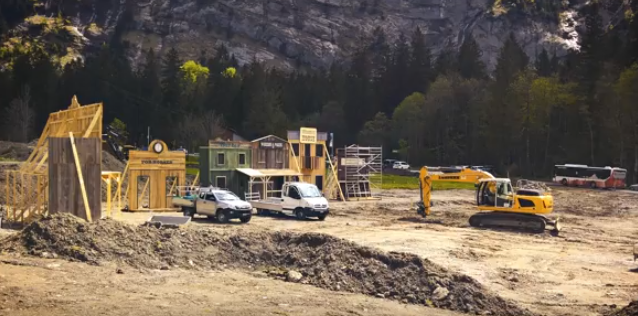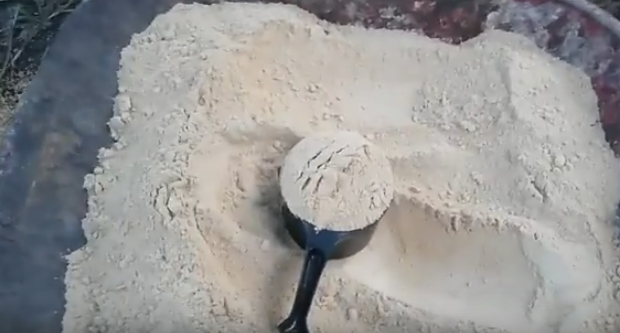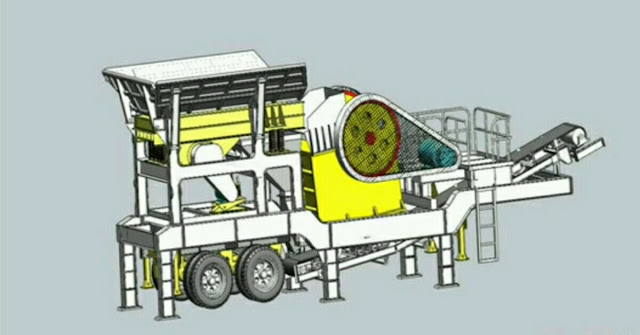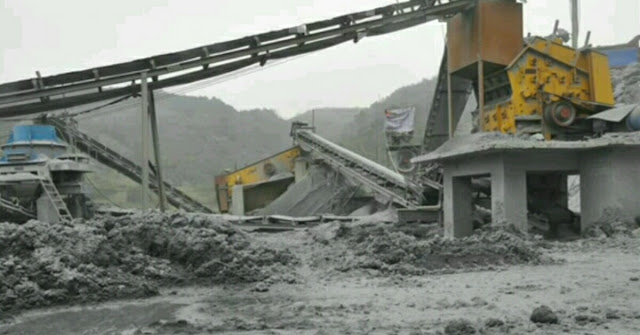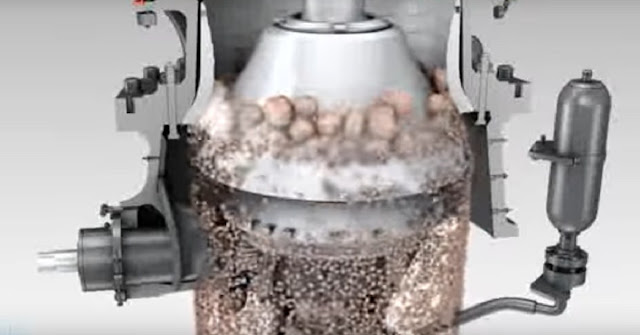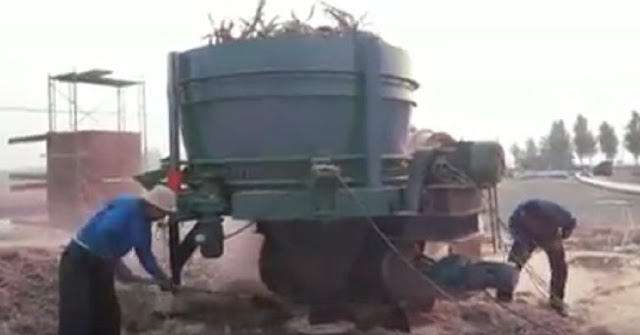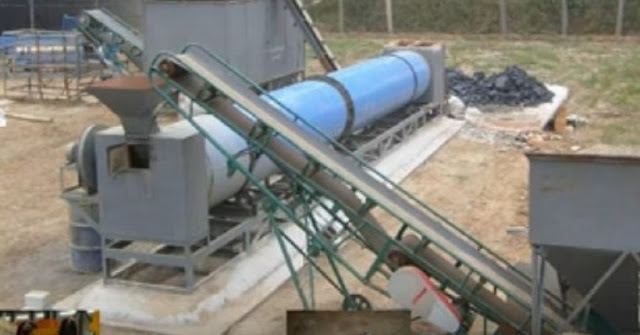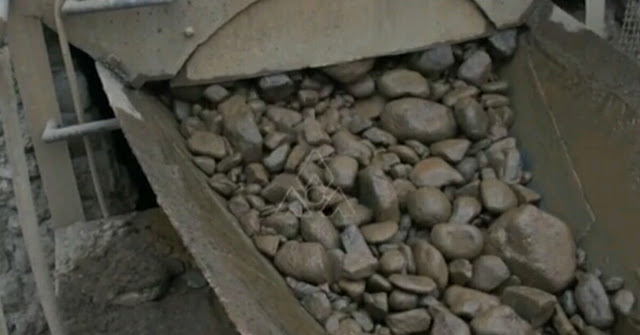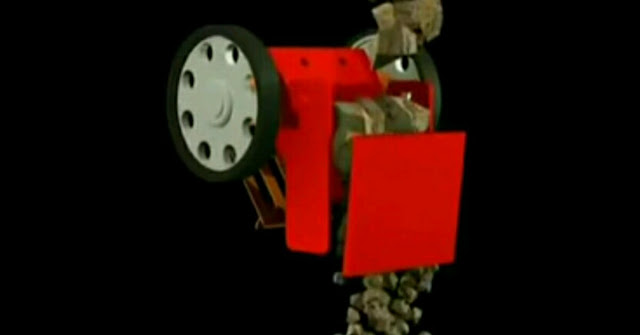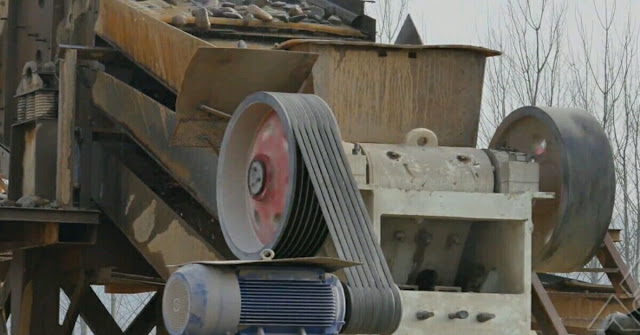Jaw
11:35
Jaw crusher industrial application
Jaw crusher applications are commonly used in mining, building materials, chemicals, metallurgy and other industries. This machine is suitable for the primary and secondary destruction of all types of minerals and rocks with a compression strength of about 320 MPa such as iron ore, copper ore, gold ore, manganese ore, rock flow, granite, basalt, quartz, and materials from other excavations.
Table of contents
1. Jaw crusher, operating principle.
2. The rendezvous of the jaw crusher.
3. The design of jaw crushers.
As you know, the crusher is called any device intended for crushing, d. H. A mechanical action on solid materials for destruction and minor parts resulting therefrom. The unconventional "Machine Industrial Association" plans and produces equipment for processing plants, mines and processing plants, including crushers, including jaw crushers.
One of the most important processes in mineral processing technology is crushing, and the most important material involved in this process is the crushing of equipment or crushers. This material focuses on jaw crushers. These are crushers that destroy a material by compression between special flat surfaces called cheeks.
In this, an abrasive surface is fixed, and the fragmentation occurs due to the approach of the movable cheek to this fixed. At the same time, the grinding surfaces are at a small angle to each other and approach from below.
The moving grinding surface of the jaw crusher reciprocates, which in turn reduces or increases the distance between the cheeks, resulting in significant pressure and cutting forces destroying the material.
The large pieces of shredded material are introduced under pressure into the working space between the jaws of the crusher. When the movable cheek approaches the solid, they are crushed into smaller ones. As the movable cheek is removed from the fixed fixture, the pieces of crushed material already crushed fall and the largest pieces remaining in place then sink into the empty space and are again ground on the mobile cheek at the next approach cycle. By adjusting the width of the gap between the cheeks and the frequency of their approach, it is possible to influence the final size of the crushed material at the outlet and the flow rate of the product to be ground.
Therefore, jaw crushers belong to a group of batch and free discharge machines under the influence of the gravity of the shredded products.
Jaw crushers are universal machines for shredding materials. It is used for crushing rocks of all types of power, slag and some metallic materials.
Jaw crushers are used in all crushing zones: large, medium and small. The input granulometry of the fractured material can reach 1500 mm. The final product size for small jaw crushers can be 10 mm.
In the technological processes of mining, jaw crushers are mainly used for grinding ferrous and non-ferrous metals, coal, shale, shale, non-metallic ores and others, mainly (1500-350 mm). ) and means.
The maximum degree of comminution of materials in jaw crushers is eight. In general, this figure is even lower, for example, working tongs breakers in cement production conditions with crushing levels of 3 to 6 in treatment and extraction plants and factories enjoy benefits close to the 3rd. , The material contained in jaw crushers may be inherently moist. Normal work occurs when the moisture content of the material reaches 6 to 8%. The actual performance of a jaw crusher and shredded material depends on the properties of the material, its origin (geology) and extraction method.
Jaw crushers: The most common type of treatment equipment in treatment plants. The specific energy consumption for shredding is between 0.3 and 1.1 kWh / t.
Due to the peculiarities of the crushing process in a jaw crusher, the final product may contain 25 to 50% of flat grains and slabs. If the process places great demands on the shape of the resulting grains, the jaw crushers should only be used in the pre-breaking phase. The finishing of the final product must be done in cone or rotary crushers.
The main advantages of jaw crushers: Simple design, easy replacement of wearing parts and spacer plates, easy maintenance and repair, are suitable for grinding viscous and clay minerals.
Disadvantages of jaw crushers: high vibrations, which require the installation of crushers on a very firm base, which does not allow their installation in the upper floors; it requires a uniform power supply, it can not work "under the rubble" and therefore the charger must be installed; few are suitable for lime grinding; Your spare parts wear out faster than those of cone crushers.
Jaw crushers are not used to destroy viscoelastic materials such as wood, polymers and some metal alloys.
Now let's talk about the design features of jaw crushers. Despite the variety of specific design features, most modern jaw crushers are manufactured on the basis of designs developed more than 100 years ago.
The basic principle of the jaw crusher is pretty simple. The grinding chamber is arranged wedge-shaped, it consists of two grinding surfaces, also called "cheeks". One of the jaws of the crusher is fixed and the second is attached to the connecting rod which causes movement of the upper edge of the cheek so that it makes a rocking motion.
The material to be crushed is introduced from above into the crushing chamber. Due to the wedge-shaped grinding chamber, the pieces of material are first arranged depending on the size of the chamber from top to bottom along the chamber height.
The connecting rod shaft is driven by a V-belt drive from an electric motor or a diesel engine. When approaching the cheeks, tissue pieces are compressed as they compress; When moving the movable cheek (inactive), the crushed pieces move under the action of gravity down. As soon as the size of the pieces reaches a predetermined value (reduced to the size of the outlet), they leave the grinding chamber and larger parts are inserted. Then the cycle repeats.
The construction of the movable cheek offers the possibility of adjusting the position of the lower edge horizontally. Therefore, the size of the groove of the outlet opening is fixed, which determines the maximum size of the crushed material at the exit of the jaw crusher. The side walls of the crushing chamber of a jaw crusher are not involved in the grinding process.
The design of the jaw crusher must ensure the following:
The type of movement of the movable cheek depends on the kinematic properties of the jaw-breaker mechanism. In applying these crushers for processing various materials, many of the most diverse kinematic schemes of the jaw crusher mechanism have been proposed.
Crushers with a simple movement of the movable cheek (WFP).
The crusher is installed with a simple movement of the movable cheek into the frame, on whose side walls the main bearings of the eccentric shaft are fixed. In the eccentric part of the tree hangs a crank. In the lower part of the connecting rod are the slots for the installation of support boxes of the spacer plates. During rotation of the eccentric shaft, the rod receives a rolling motion, which is transmitted by means of the spacer plates on the movable cheek. The cheek receives a pendulum motion with a center point on the axle of the suspension. The fixed and movable sanding plates are attached to the cheeks.
The width of the exit slot is adjusted by installing additional spacers of different thicknesses between the anvil and the rear wall of the frame, a system of wedges in the screws, or the replacement of the rear spacer plate by a longer or a shorter one.
The crushers have only one turn: the ability to crush high-strength rocks and the wear of the sanding plates relatively low. The disadvantage is a high metal content compared to complex jaw crushers and a big difference in the resulting fraction.
Breaker with a complex movement of the movable cheeks
The crusher with a complex movement of the cheek has a special design of the movable cheek. Due to the eccentric attachment of the upper end, the cheek has a complex movement: in the upper support it makes circular movements and down, at the outlet end it is elliptical. As a result, the ore pieces are not only crushed, but also abrasive.
To adjust the width of the exit slot, use a device that raises and lowers a vertical adjustment wedge with a screw. A housing is provided to prevent the emission of shredded materials. The safety device is usually the spacer plate itself, which breaks when the permissible load is exceeded, whereby the failure of the most responsible and expensive crushing units is avoided.
Shredder shredders with complex cheek movements are completely transferred to the eccentric crankshaft, so that shredders of this type are not made in large dimensions and are not used for heavy crushing. Jaw crushers type DSDS are used for grinding relatively small, low abrasives with high clay and moisture content. The width of the receiving opening generally does not exceed 600 mm and the exit slot has a width of 20 to 200 mm.
graduation
The main improvement direction for jaw crushers is the selection of the best design parameters, such as: B. the ratio between the height of the working space and the width of the receiving hole. For the best jaw crushers, this value is 2.25 to 2.5: 1 compared to 2: 1 before the update. Improvement of the geometric shapes of the cladding panels as well as the mechanism of the drive mechanism that allows a soft start of a jaw crusher and protects it from damage when passing non-shredder bodies or overflowing shredders with minerals
In development and a promising new type of jaw crusher - vibration. The operation of these shredders takes the form of vibrators with automatic unbalance synchronization. The main advantage of vibration jaw crushers is a high degree of grinding (more than 10) and a reduction in energy consumption.
In addition to production, specialists for non-standard equipment "Machine Industry Association" carry out technical diagnoses. All work on the technical diagnosis of jaw crushers involves the determination of the technical condition of the structures and the determination of the suitability of their elements for additional operations.
Table of contents
1. Jaw crusher, operating principle.
2. The rendezvous of the jaw crusher.
3. The design of jaw crushers.
1.Jaw crusher, operating principle.
 |
| The working principle of a Jaw crusher must be understood before choosing this machine |
As you know, the crusher is called any device intended for crushing, d. H. A mechanical action on solid materials for destruction and minor parts resulting therefrom. The unconventional "Machine Industrial Association" plans and produces equipment for processing plants, mines and processing plants, including crushers, including jaw crushers.
One of the most important processes in mineral processing technology is crushing, and the most important material involved in this process is the crushing of equipment or crushers. This material focuses on jaw crushers. These are crushers that destroy a material by compression between special flat surfaces called cheeks.
In this, an abrasive surface is fixed, and the fragmentation occurs due to the approach of the movable cheek to this fixed. At the same time, the grinding surfaces are at a small angle to each other and approach from below.
The moving grinding surface of the jaw crusher reciprocates, which in turn reduces or increases the distance between the cheeks, resulting in significant pressure and cutting forces destroying the material.
The large pieces of shredded material are introduced under pressure into the working space between the jaws of the crusher. When the movable cheek approaches the solid, they are crushed into smaller ones. As the movable cheek is removed from the fixed fixture, the pieces of crushed material already crushed fall and the largest pieces remaining in place then sink into the empty space and are again ground on the mobile cheek at the next approach cycle. By adjusting the width of the gap between the cheeks and the frequency of their approach, it is possible to influence the final size of the crushed material at the outlet and the flow rate of the product to be ground.
Therefore, jaw crushers belong to a group of batch and free discharge machines under the influence of the gravity of the shredded products.
2.The rendezvous of the jaw crusher.
Jaw crushers are universal machines for shredding materials. It is used for crushing rocks of all types of power, slag and some metallic materials.
Jaw crushers are used in all crushing zones: large, medium and small. The input granulometry of the fractured material can reach 1500 mm. The final product size for small jaw crushers can be 10 mm.
In the technological processes of mining, jaw crushers are mainly used for grinding ferrous and non-ferrous metals, coal, shale, shale, non-metallic ores and others, mainly (1500-350 mm). ) and means.
The maximum degree of comminution of materials in jaw crushers is eight. In general, this figure is even lower, for example, working tongs breakers in cement production conditions with crushing levels of 3 to 6 in treatment and extraction plants and factories enjoy benefits close to the 3rd. , The material contained in jaw crushers may be inherently moist. Normal work occurs when the moisture content of the material reaches 6 to 8%. The actual performance of a jaw crusher and shredded material depends on the properties of the material, its origin (geology) and extraction method.
Jaw crushers: The most common type of treatment equipment in treatment plants. The specific energy consumption for shredding is between 0.3 and 1.1 kWh / t.
Due to the peculiarities of the crushing process in a jaw crusher, the final product may contain 25 to 50% of flat grains and slabs. If the process places great demands on the shape of the resulting grains, the jaw crushers should only be used in the pre-breaking phase. The finishing of the final product must be done in cone or rotary crushers.
The main advantages of jaw crushers: Simple design, easy replacement of wearing parts and spacer plates, easy maintenance and repair, are suitable for grinding viscous and clay minerals.
Disadvantages of jaw crushers: high vibrations, which require the installation of crushers on a very firm base, which does not allow their installation in the upper floors; it requires a uniform power supply, it can not work "under the rubble" and therefore the charger must be installed; few are suitable for lime grinding; Your spare parts wear out faster than those of cone crushers.
Jaw crushers are not used to destroy viscoelastic materials such as wood, polymers and some metal alloys.
3. The design of jaw crushers.
Now let's talk about the design features of jaw crushers. Despite the variety of specific design features, most modern jaw crushers are manufactured on the basis of designs developed more than 100 years ago.
The basic principle of the jaw crusher is pretty simple. The grinding chamber is arranged wedge-shaped, it consists of two grinding surfaces, also called "cheeks". One of the jaws of the crusher is fixed and the second is attached to the connecting rod which causes movement of the upper edge of the cheek so that it makes a rocking motion.
The material to be crushed is introduced from above into the crushing chamber. Due to the wedge-shaped grinding chamber, the pieces of material are first arranged depending on the size of the chamber from top to bottom along the chamber height.
The connecting rod shaft is driven by a V-belt drive from an electric motor or a diesel engine. When approaching the cheeks, tissue pieces are compressed as they compress; When moving the movable cheek (inactive), the crushed pieces move under the action of gravity down. As soon as the size of the pieces reaches a predetermined value (reduced to the size of the outlet), they leave the grinding chamber and larger parts are inserted. Then the cycle repeats.
 |
| Material that has been processed on a jaw crusher machine |
The construction of the movable cheek offers the possibility of adjusting the position of the lower edge horizontally. Therefore, the size of the groove of the outlet opening is fixed, which determines the maximum size of the crushed material at the exit of the jaw crusher. The side walls of the crushing chamber of a jaw crusher are not involved in the grinding process.
The design of the jaw crusher must ensure the following:
- 24-hour operation with maintenance stops;
- Protection of lubricated surfaces of the powder;
- Start with your own record.
- Protection of parts (except the safety part) against breakage when non-commutation bodies hit the grinding chamber;
- During operation, no crushed material is released;
- Safe access to mounting points for wear, adjustment and lubrication parts;
- the possibility of installing the consumer-made frame for individual or typical shelters for the suction of dusty air in the area of ??loading and unloading of material;
- Local and remote control of grinding mechanisms.
The type of movement of the movable cheek depends on the kinematic properties of the jaw-breaker mechanism. In applying these crushers for processing various materials, many of the most diverse kinematic schemes of the jaw crusher mechanism have been proposed.
Crushers with a simple movement of the movable cheek (WFP).
The crusher is installed with a simple movement of the movable cheek into the frame, on whose side walls the main bearings of the eccentric shaft are fixed. In the eccentric part of the tree hangs a crank. In the lower part of the connecting rod are the slots for the installation of support boxes of the spacer plates. During rotation of the eccentric shaft, the rod receives a rolling motion, which is transmitted by means of the spacer plates on the movable cheek. The cheek receives a pendulum motion with a center point on the axle of the suspension. The fixed and movable sanding plates are attached to the cheeks.
The width of the exit slot is adjusted by installing additional spacers of different thicknesses between the anvil and the rear wall of the frame, a system of wedges in the screws, or the replacement of the rear spacer plate by a longer or a shorter one.
The crushers have only one turn: the ability to crush high-strength rocks and the wear of the sanding plates relatively low. The disadvantage is a high metal content compared to complex jaw crushers and a big difference in the resulting fraction.
Breaker with a complex movement of the movable cheeks
The crusher with a complex movement of the cheek has a special design of the movable cheek. Due to the eccentric attachment of the upper end, the cheek has a complex movement: in the upper support it makes circular movements and down, at the outlet end it is elliptical. As a result, the ore pieces are not only crushed, but also abrasive.
To adjust the width of the exit slot, use a device that raises and lowers a vertical adjustment wedge with a screw. A housing is provided to prevent the emission of shredded materials. The safety device is usually the spacer plate itself, which breaks when the permissible load is exceeded, whereby the failure of the most responsible and expensive crushing units is avoided.
Shredder shredders with complex cheek movements are completely transferred to the eccentric crankshaft, so that shredders of this type are not made in large dimensions and are not used for heavy crushing. Jaw crushers type DSDS are used for grinding relatively small, low abrasives with high clay and moisture content. The width of the receiving opening generally does not exceed 600 mm and the exit slot has a width of 20 to 200 mm.
graduation
The main improvement direction for jaw crushers is the selection of the best design parameters, such as: B. the ratio between the height of the working space and the width of the receiving hole. For the best jaw crushers, this value is 2.25 to 2.5: 1 compared to 2: 1 before the update. Improvement of the geometric shapes of the cladding panels as well as the mechanism of the drive mechanism that allows a soft start of a jaw crusher and protects it from damage when passing non-shredder bodies or overflowing shredders with minerals
In development and a promising new type of jaw crusher - vibration. The operation of these shredders takes the form of vibrators with automatic unbalance synchronization. The main advantage of vibration jaw crushers is a high degree of grinding (more than 10) and a reduction in energy consumption.
In addition to production, specialists for non-standard equipment "Machine Industry Association" carry out technical diagnoses. All work on the technical diagnosis of jaw crushers involves the determination of the technical condition of the structures and the determination of the suitability of their elements for additional operations.

